What would happen if you were to pass away before the mortgage on your home is paid off? Will your loved ones have enough money to keep current on the loan?
One option is mortgage protection insurance, also called mortgage life insurance, which pays off your mortgage in the event of your passing. Mortgage protection insurance isn’t right for everyone, however, so it’s important to weigh the pros and cons carefully, and understand how this type of policy contrasts with other kinds of coverage — specifically, life insurance.
What is mortgage protection insurance?
Mortgage protection insurance is a form of life insurance that’s designed to pay off your mortgage debt in the event you pass away before the balance is paid in full. Some policies also cover you in other instances: If you become too disabled to work or become unemployed — anything that impacts your income enough to endanger your making mortgage payments.
“Typically, mortgage protection insurance is sold as an option after closing on your home,” explains Herb Dorow, an agent with Maris Brown Insurance Group in Rochester Hills, Michigan. “The life insurance amount of the policy is tied to your mortgage amount. As your mortgage amount decreases, so does the benefit, but the premium does not decrease.”
“Traditionally, when someone takes out a mortgage protection policy, they are trying to cover the amount of the mortgage for the period they are set up to pay on the mortgage,” says Tyler Rees, owner of Innovative Financial Group in Wilmington, North Carolina.
Mortgage protection insurance is usually costlier than life insurance — but still relatively inexpensive, at about $100 or less a month — and sold by mortgage companies, banks or independent insurance companies.
“Each policy will be priced based on age, sex, location, amount of the mortgage and term of the mortgage,” says J. Keith Baker, chair of curriculum for Mortgage Banking at Dallas College in Irving, Texas. “A healthy 25-year-old man living in Indiana would probably pay as little as $26.45 a month for $100,000 worth of coverage on a 30-year mortgage.”
That’s a lot more than that same person can expect to pay for a 30-year term insurance policy with $100,000 worth of coverage. In this case, the policyholder could pay as little as $13.85 a month, according to Baker, citing a Transamerica online premium estimator.
Mortgage protection insurance after death
Unlike a typical life insurance policy, MPI doesn’t pay your family a lump sum upon your death. Instead, your insurer will pay your mortgage lender directly: a death benefit equivalent to a set number of monthly mortgage payments — the ones left outstanding.
Say, for instance, you take out a mortgage loan for $300,000 at 3.1 percent interest over 30 years to buy a home. You purchase a mortgage protection policy for the same term – 30 years – with a face value of $300,000.
Now, assume you pass away 10 years after taking out the loan and insurance policy, leaving behind a roughly $228,000 unpaid mortgage balance. In this case, your mortgage life insurance policy would pay off the $228,000 balance in full.
Mortgage protection insurance vs traditional life insurance
Unlike term or whole/permanent life insurance, mortgage protection insurance involves minimal to no underwriting, which makes it easier to qualify for. “You don’t need to undergo a medical exam to get coverage,” Baker notes. Your premium won’t depend on factors like your occupation or health.
The downside is that MPI is more expensive: The average MPI payment will be higher than a comparable life insurance policy on the same benefit. Furthermore, most MPI policies stipulate that your outstanding benefit shrinks as you make more mortgage payments over time and get closer to paying it off). In other words, your MPI policy becomes less valuable the longer you pay. By comparison, most traditional life insurance policies retain the cash benefit over time.
“With traditional term or permanent life insurance, the amount of coverage does not decrease and you control the policy,” Dorow says.
Control also comes into play when payoff time arrives. With life insurance, your beneficiaries receive a lump-sum cash benefit upon your death. The payout for mortgage protection insurance, on the other hand, goes directly toward paying off your mortgage; the money can’t be used by your beneficiaries for any other purpose. That includes other common homeownership costs, like HOA dues, property taxes and homeowners insurance premiums.
Who should get mortgage protection insurance?
Mortgage protection insurance can make sense for the right candidate. If you’re considered a risky proposition to a life insurance company, mortgage protection insurance may be a cheaper and more viable option.
“It can be somewhat more competitive for someone aged 50 to 60 years old who has some health issues that may make purchasing a standard life insurance policy difficult or more expensive,” Baker says. “Also, folks with dangerous professions who cannot get reasonable cost coverage, like a race car driver or skydiving instructor, should consider this insurance.”
Final word on mortgage protection insurance vs life insurance
The biggest difference between MPI and life insurance lies in who receives the funds and flexibility in using them.With a traditional life insurance policy, your family receives the funds and can spend the money however they like. However, with mortgage protection insurance, your mortgage lender is the policy’s beneficiary — it receives the payout.
The upside is that the mortgage is taken care of, without being an additional burden or concern to your survivors. Of course, it also denies them any control over the money. By that measure, life insurance offers more flexibility, because it can cover whatever you want it to, including your home loan. “You can purchase coverage that exceeds just your mortgage amount,” as Dorow notes.
Your family can’t depend on MPI to cover other bills and ongoing expenses, as they can with a life insurance policy. Still, this form of insurance will help ensure that they keep their home.





